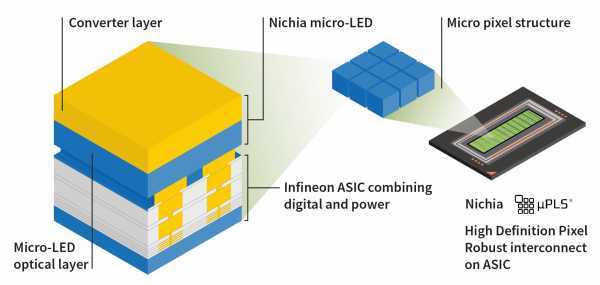
"The new 16,384-pixel µPLS micropixel lighting solution is our latest addition to Nichia's portfolio of high-end automotive lighting solutions," says Nichia's Yusuke Yamazaki, "It combines high resolution with the industry's highest light output, providing a four-times wider field of view with significantly higher light output than any other current micromirror-based HD matrix solution. For this reason, the advanced HD headlight can warn drivers of danger by illuminating people or objects on or near the side of the road. It can also project road markings to guide the driver through a construction site or intersection. In addition, features such as glare-free high beam or cornering light work more precisely and smoothly compared to current adaptive high beam solutions. This brings driver safety on the road and driving comfort to a new level. headlight />
"µPLS is the industry's first fully integrated matrix LED driver capable of driving 16,384 LEDs, combining all the necessary micro-LED driver chips with extensive diagnostics and high-speed video and control interfaces," says Andreas Doll of Infineon, "we are realizing our vision Customers can deploy fully digital road lighting, saving total system cost in a very small form factor the size of a single semiconductor chip. µPLS is another great example of how Infineon products support digitization as well as decarbonization towards a net-zero society.”
The HD light engine uses Nichia's micro-LED technology and an integrated LED driver chip from Infineon that can control all 16,384 micro-LEDs individually using pulse-width modulation (PWM) control.
In addition, the driver IC controls each micro-LED individually and provides on-chip temperature monitoring for optimal temperature control. Integrated video interfaces provide high-speed video signal transmission from the light pattern generator unit.
Unlike current high-definition matrix solutions, Infineon's driver chip activates only the LEDs that are actually needed for the light pattern. This increases the energy efficiency of the µPLS light engine in a much smaller form factor compared to existing micro-mirror-based HD arrays.
This allows for smaller and thinner headlights in the future. In addition, the new HD illumination mechanism provides settings that can be digitally programmed at the factory or activated by the vehicle manufacturer or the driver on demand.
For example, the different requirements of left-handed and right-handed people. can be considered, increasing usability.
Source: electronicsweekly.com










